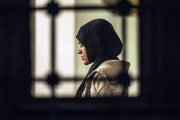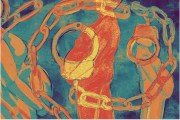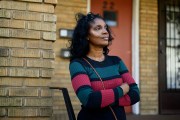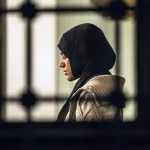This article was originally published by The Emancipator.
Muna Osman Jama was marking the last days of Ramadan with her husband, 10 years ago this July, when a swarm of federal law enforcement agents rushed through the door of their Reston, Virginia home. They handcuffed her and pushed her husband to the floor.
Jama, a naturalized U.S. citizen born in Somalia, recalled the moment as chaotic and frightening. “I need to dress up,” she told them. “I’m not wearing clothes.”
When the officers entered her home, Jama was dressed in an abaya, an Islamic dress-like item that covers the body from the shoulders down. She was also wearing a hijab. Upon arresting Jama, officers ordered her to remove both — which left her dressed in a sleeveless pajama top and tight pajama bottoms. Jama told the officers she needed the proper attire to cover herself. She was given a T-shirt from home, which she used to create a makeshift hijab while also trying to cover her arms.
At the police station where she was booked following her arrest, officers ignored Jama’s plea for proper covering.
“This is against my religion. I cannot take it [the hijab] off,” she told officers. Three guards hit her in response. Jama told them she could be pregnant. “Then, I knelt on the ground, and someone wearing a white shirt stepped on my feet with his boots.”
The situation in prisons
Muslims constitute only about 1 percent of U.S. inhabitants, but they make up 9 percdent of the country’s state and federal prison population. A growing number of incarcerated Muslim women have been denied the right to wear religious garments when arrested or imprisoned. Examples include a lack of access to prayer spaces to food denial during Ramadan to accessing religious texts.
“I’ve personally seen roughly 30 complaints come in just to our office of Muslim women who had their hijab taken off in some capacity by a prison or police officer, and almost 10 of whom had that photo go public online,” said Aya Beydoun, a legal fellow for the Council on American-Islamic Relations. Her organization has represented — and sued on behalf — of incarcerated Muslim women across the country.
Beydoun believes that a lack of education about Islamic practices has largely contributed to the discrimination Muslim women face. “It is not an uncommon belief among Americans that women who wear the hijab are somehow oppressed,” she said. “There are those in positions of power who see themselves as some kind of savior for telling these women they don’t need to wear their hijab.”
During her incarceration — she was ultimately sentenced to 12 years in federal prison — Jama had to drape a blanket over her head because prison officials would not give her a hijab. She brought her hijab complaint to the prison psychologist, who Jama assumed would be understanding because she was also Black. However, Jama said the psychologist attempted to draw parallels with Saudi Arabia’s practices of forcing women to adhere to a strict dress code.
Eventually, the psychologist gave Jama two sheets: one for praying and the other to cover herself.
-
Read Next:
“The primary challenge is bias,” said Christopher Godshall-Bennett, a staff attorney at the civil rights organization Muslim Advocates. “There’s this huge amount of skepticism and bias when Muslims who are incarcerated try to practice their faith.”
As Godshall-Bennett notes, there are more practical and daily components to practicing Islam compared to other religions, such as access to clean water for daily wudu, which is necessary for the five daily prayers and halal meals. This makes it more challenging to fulfill requests like asking for a particular food, such as dates to break the Ramadan fast; an adequate environment for prayer; and proper attire, like a hijab.
Jama also struggled with breaking fasts during Ramadan, as she was often uncertain whether it was day or night. When she asked the guards about the time, she was met with silence. The last meal was typically served around 5:30 p.m. or 5:40 p.m., prompting Jama to extend her fasting period beyond this point.
Despite her challenges, Jama sustained her fast. “I just drank water the first three days. I didn’t eat anything,” she said. “I was just breaking my fast with water and continued fasting.”
Godshall-Bennett noted that incarcerated people can try to advocate for their rights through an injunction, which is a court order that requires a facility to better accommodate their needs. This can be a significant issue, especially during Ramadan. “By the time you’re able to challenge the denial of an accommodation, Ramadan is over,” Godshall-Bennett said.
Another incarcerated person, A.H., who is serving a life sentence for murder and robbery at an Arizona facility, converted to Islam after her incarceration began in 2018. As a prison convert with scarce support from outside Muslim communities, she had trouble adapting to her newly found faith while in prison. According to A.H., prison policies only allowed women to wear the hijab during prayer. “Denial of hijab is robbery,” she said. “It is a violent spiritual theft. It is the equivalent of ripping off a woman’s clothing in public.”
One day, A.H. decided to break those rules “by simply walking outside my cell in my hijab, and waiting for them to attack me in whatever way they wanted,” she said.
“My family was in communication with the central office, the head of chaplaincy and the director, and finally in 2021, they changed the policy to allow us to wear hijab,” A.H. said.
Nusayba Elqabbany, a program coordinator and coach at the Tayba Foundation, a nonprofit that works with the families of incarcerated individuals, highlighted the unique hardships faced by Muslim women.
-
Read Next:
“The prison system, fundamentally built on exploiting individuals, presents the first hurdle for incarcerated Muslim women,” Elqabanny said. “The system fails to accommodate aspects like pregnancy and motherhood. The intersection of being a woman, a minority and a Muslim within a system inherently designed with Christianity in mind creates a multifaceted struggle for incarcerated Muslim women.”
Incarcerated Muslim people struggle to obtain religious texts and accommodations for prayer; also, they are often charged a higher price for religious texts such as the Qu’ran as compared to the cost of a Christian Bible.
“Celebrations centered around Christian holidays and themes, coupled with a lack of understanding of Islamic practices, create a disconnect for Muslim women,” Elqabbany said. But there is a “need for cultural sensitivity in the prison system to ensure fair treatment and rehabilitation for all, such as being allowed to congregate for an Eid feast.”
“Restrictions on religious materials persist, from strict guidelines on hijab measurements and colors to limitations on the number of books allowed,” Elqabbany said “Additionally, the turnover rate and the absence of a cohesive Muslim community within prisons contribute to a lack of education on basic religious practices.” Elqabbany recalled one incarcerated person who had been a Muslim for more than 20 years but had no idea how to pray.
Jessica Clark embraced Islam in 2016 while serving time at State Correctional Institution Cambridge Springs, a minimum security prison for women in Crawford County, Pennsylvania. While imprisoned, she faced challenges accessing religious materials, including prayer mats and tasbeeh (prayer beads).
“Sometimes the librarian would snag up any Quran she could find for me, or she would stick them in the back corner,” she said. “If you knew about it, you could go up and ask her if she had one available, … but that was pretty far and few between.”
A potential solution would be providing resources to incarcerated Muslim people, such as more Islamic psychologists and counselors to address the unique mental health challenges. Tricia Pethic, chaplain and founder of the Muslim Prisoner Project, is part of an effort to provide much-needed support to incarcerated Muslims beyond phone calls and visits.
“A few examples are … a lack of awareness of Muslims behind bars by the local Muslim communities, which results in a volunteer shortage; and prejudice against Muslims, which includes passive neglect of Muslim prisoners by some chaplains who do not proactively seek resources but offer the bare minimum,” Pethic said.
Pethic noted a stark contrast between Islam and other faith communities. “I have the conversations and the letters to show that inmates just don’t hear back from mosques very often,” she said. “In other faith communities, they might have a dedicated ministry just for prisoners.”
Systemic changes
Even before entering prison, the arrest process can entail significant distress, especially for women asked to remove their headscarves for mugshots. These photos are public and can be found by anyone. They are often reprinted in newspapers or on websites, leading to shame, anxiety, stress, depression and PTSD.
Starting in 2020, the New York City police department stopped requiring women to remove religious coverings for mugshots following a $17.5 million class-action lawsuit filed by two Muslim women who had been forced to remove their hijabs before being photographed.
“Removing a Muslim woman’s hijab for a booking photograph is illegal,” said Beydoun. In a recent case, she said CAIR successfully sued to destroy publicized mugshot photos of a woman without a headscarf.
“Any photos in the government’s possession should be destroyed or replaced,” said Beydoun. But the rule is not always easy to enforce. “The best we can do is force the government to reach out to the media and ask them nicely to take it down.”
Though some state legislatures have made efforts to enact legislation to protect religious wear for incarcerated individuals. In October, California Gov. Gavin Newsom approved a bill laying out guidelines protecting religious clothing for people incarcerated in California prisons. The law ensures incarcerated people can retain their own religious garments until they can access equivalent clothing inside prisons.
“These ongoing battles underscore the need for systemic change within the prison system to ensure the rights and dignity of all individuals,” Elqabbany said.
“Muslims, when comparing male versus female, the sisters have far less access to resources than males,” said Sheikh Rami Nsour, founding director of the Taybah Foundation, which provides education and support for incarcerated Muslims. “Because there’s that disparity because of the brother side, there’s more access to resources to chaplains to larger congregations of Muslim prisoners. Because there is that disparity, we try to make up for that by giving extra care, focus and attention to sisters.”
-
Read Next:
Another promising change for imprisoned Muslim women comes from the Women’s Policy Institute in Los Angeles County, which has asked the sheriff and probation departments to proactively institute a policy that upholds religious tolerance and safeguards women’s bodily integrity.
The suggested policy includes provisions ensuring privacy for women in custody, allowing them to retain religious headwear in specified circumstances, and mandating searches and pat-downs by personnel of the same gender. The proposal also advocates for providing temporary religious headwear and permitting women to wear religious headwear in photographs, provided it doesn’t compromise safety. (The LA sheriff’s department did not respond to a request for comment.)
Additionally, the California Department of Corrections and Rehabilitation system told The Emancipator it offers halal food. Alia Cruz, a spokesperson for the department, said the system “respects all sincerely held religious beliefs and strives to reasonably accommodate individuals practicing those beliefs.” She added that the prison system also allows incarcerated people to buy and possess “religious headgear, prayer rugs and reading material.”
The ability of incarcerated people to continue living in alignment with one’s beliefs is also crucial for reintegration into society and their community.
“Mostly revert Muslim women find it [to be] a difficult transition from incarceration back into society because the application of faith in real time can cause a bit of digression. I think that community support is essential,” said Kareemah Hanifa, Atlanta community organizer with the Inner-City Muslim Action Network. Hanifa served 26 years at a Georgia Department of Corrections facility.
“As the daughter of an Imam, I found it a smooth transition back into community life,” she said. “I think if each Muslim woman is permitted to wear her hijab in alignment with what she believes Allah requires of her, it would be an easier transition from incarceration into the masjid [or mosque].”
Beydoun, who has been working on Jama’s case, fighting for Muslim women rights within the prison system, has shared that CAIR filed a complaint for Jama, “addressing the removal of her hijab for her booking photo and ID card at FCI WASECA,” said Beydoun.
She noted that CAIR has only filed a complaint at her current facility but not every prison that she had spent time in.
“Part of our request in our current lawsuit is for the BOP to institute policy changes that will properly accommodate the religious exercise of those Incarcerated at their facility like Ms. Jama,” she said. “This includes accommodating, modest dress by providing long sleeve uniforms, which are easily attainable. As well as, of course, changing their booking policies so that there are exceptions for those who wear religious headwear like the hijab.”
The lawsuit is filed in the U.S. District Court of Minnesota as Jama v. Peters.
“Thus far, we were able to reach an agreement with the BOP to replace Ms. Jama’s jail ID card photo with a new one that features her hijab,” added Beydoun. “They also replaced all the other copies of the photo in the facility. However, they retain a segregated copy of the hijab-less photo which we still hope to have destroyed. We will be defending the case in a motion to dismiss hearing on June 11th.”
This reporting project from The Emancipator was completed with the support of a grant from Columbia University’s Ira A. Lipman Center for Journalism and Civil and Human Rights in conjunction with Arnold Ventures.









